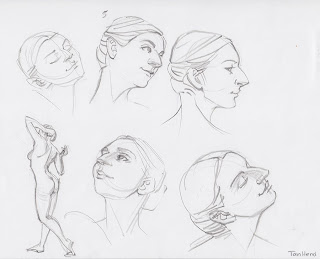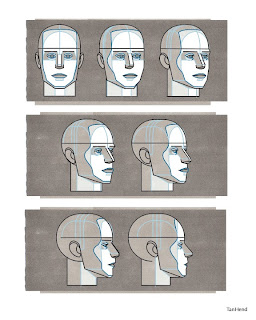Brant in Karl Gnass's Figure Drawing Class
Tuesday, December 31, 2013
Saturday, December 7, 2013
Sunday, November 24, 2013
Sunday, November 17, 2013
Saturday, November 16, 2013
Sunday, November 3, 2013
Tuesday, October 29, 2013
Face It - Model Testing
These are all drawn from a book called Face It: A Visual Reference For Multi-Ethnic Facial Modeling I was very happy to find this reference, it has a lot of photos of a variety of different looking people with front, both profile views, both 3/4 front and both 3/4 back views for each person as well as some expressions.
I'm looking at my general model as I draw these, looking to see how they deviate from it and looking to see how I can revise the model to work better. I used a circle template for a bunch of them to try and keep the sizes consistent, and the last set was drawn with my most recent 3/4 general model actually under paper. I was specifically looking at how to define the side plane the silhouette of the far side of the face.
Sunday, October 27, 2013
Saturday, October 26, 2013
Monday, October 21, 2013
Saturday, October 19, 2013
Saturday, October 12, 2013
Saturday, October 5, 2013
Sunday, September 29, 2013
Cones and Seeing vs Feeling
From Harold Speed's The Practice and Science of Drawing:
"If you are asked to think of an object, say a cone, it will not, I think, be the visual aspect that will occur to most people. They will think of a circular base from which a continuous side slopes up to a point situated above its centre, as one would feel it. The fact that in almost every visual aspect the base line is that of an ellipse, not a circle, comes as a surprise to people unaccustomed to drawing.
The fact that we have two flat pictures on our two retinas to help us, and that we can focus at different planes, would not suffice to account for our knowledge of the solidity and shape of the objective world, were these senses not associated with another sense all important in ideas of form, the sense of touch."
Sunday, September 22, 2013
Trees
From Karl Gnass's Landscape sketch and composition class at Malibu Creek State Park. Trying to create simple volumes.
Sunday, September 15, 2013
Models: testing our imagination
"There is a less familiar way in which a scientist can work out what is real when our five senses cannot detect it directly. This is through the use of a 'model' of what might be going on, which can then be tested. We imagine - you might say we guess- what might be there. That is called the model. We then work out (often by doing a mathematical calculation) what we ought to see, or hear, ect. (often by doing a mathematical calculation) if the model were true. We then check whether that is what we actually do see. The model might literally be replica made out of wood or plastic, or it might be a piece of mathematics on paper, or it might be a simulation in a computer. We look carefully at the model and predict what we ought to see(hear, ect.) with our senses (with the aid of instruments, perhaps) if the model were correct. Then we look to see whether the predictions are right or wrong. If they are right, this increases our confidence that the model really does represent 'reality' we then go on to devise further experiments , perhaps refining the model, to test the findings further and confirm them. If our predictions are wrong, we reject the model, or modify and try again."
Excerpt from - The Magic of Reality: How We Know What's Really True
by Richard Dawkins, beautifully illustrated by David McKean
by Richard Dawkins, beautifully illustrated by David McKean
Subscribe to:
Comments (Atom)






















































